
The chalkhill blue is a butterfly in the family Lycaenidae. It is a small butterfly that can be found throughout the Palearctic realm, where it occurs primarily in grasslands rich in chalk. Males have a pale blue colour, while females are brown. Both have chequered fringes around their wings.

The Adonis blue is a butterfly in the family Lycaenidae. It inhabits the Palearctic realm.
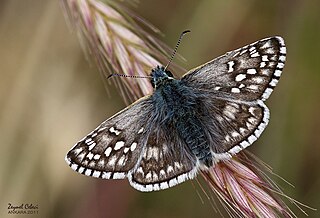
Pyrgus sidae, the yellow-banded skipper, is a species of skipper. It is found in from the Iberian Peninsula through southern and eastern Europe, southeast France, the northwestern coastal areas of central Italy, then Istria and the Balkan peninsula, across Turkey, Transcaucasia, to Iran and Afghanistan. East of the Southern Ural mountains the range extends to northwest Kazakhstan and the west of the Tien Shan in the north.
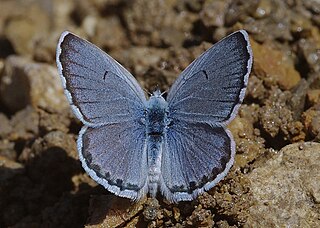
Pseudophilotes vicrama, the eastern baton blue, is a small butterfly found in Asia, east to Tian Shan and parts of China, west to the Balkans, Turkey, eastern Europe to southern Finland. It belongs to the lycaenids or blues family. The species was first described by Frederic Moore in 1865.

Polyommatus eros, the Eros blue or common meadow blue, is a species of blue butterfly found in the Palearctic.

Lysandra albicans, the Spanish chalk-hill blue, is a butterfly of the family Lycaenidae. It is found in Spain and Western North Africa.

Polyommatus damon, the Damon blue, is a butterfly of the family Lycaenidae.

Polyommatus daphnis, the Meleager's blue, is a butterfly of the family Lycaenidae.

Erynnis marloyi, commonly known as the inky skipper, is a species of butterfly in the family Hesperiidae. It is found in south-eastern Europe across Asia Minor to Syria, Turkey, Lebanon, southern Iran and Chitral, Pakistan.
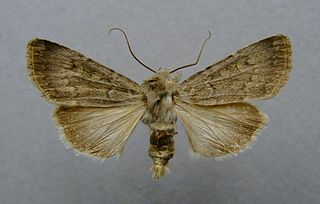
Euxoa decora is a moth of the family Noctuidae. It is found in southern and central Europe, Morocco, Algeria, the Caucasus, Armenia, Issyk-Kul, Turkey, Iran and Iraq.

Ripart's anomalous blue is a butterfly in the family Lycaenidae.

Polyommatus (Plebicula) dorylas, the turquoise blue, is a butterfly of the family Lycaenidae. It is found in southern Europe, Asia Minor, the Ural Mountains, Caucasus and Transcaucasia. Its wingspan is 15–17 mm. The butterfly's common name comes from the dazzling bright blue colour of male's wings. The larvae feed on Anthyllis vulneraria. The butterfly flies from May to September in two generations. Habitats include flowery meadows in rocky areas at 500–2000 m.
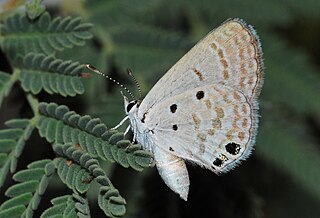
Luthrodes galba, the Persian grass blue, is a butterfly in the family Lycaenidae. It is found in southern Turkey, central and eastern Arabia, Iraq, Iran, Afghanistan, the Caucasus and Cyprus.

Chazara persephone, the dark rockbrown, is a butterfly species belonging to the family Nymphalidae. It can be found from Crimea across the Caucasus and north of the Middle East to Iran; from the southern Urals across Kazakhstan to the southern Altai and west Siberia.

Polyommatus admetus, the anomalous blue, is a butterfly of the family Lycaenidae. It was described by Eugenius Johann Christoph Esper in 1783. It is found in south-eastern Europe and Turkey.
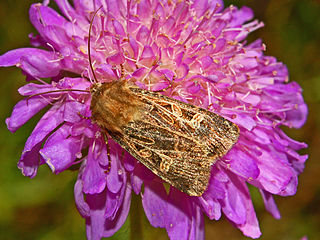
Chersotis alpestris is a moth of the family Noctuidae.

Kirinia climene, the Iranian Argus, is a butterfly of the family Nymphalidae. It was described by Eugenius Johann Christoph Esper in 1783. It is distributed in Bulgaria, Romania, Yugoslavia, Macedonia, Turkey, Caucasus, Transcaucasia, Syria, Iraq, Iran and southern Russia.
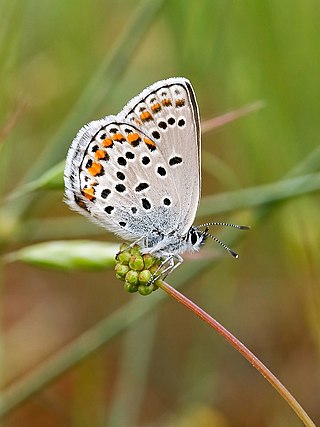
Kretania sephirus, previously known as Plebejus sephirus, is a species of butterfly that belongs to the family Lycaenidae. It is found in Eastern Europe, the Caucasus, and Asia Minor. The species is part of a species complex, with many members of the complex using variations of the name zephyr blue, including pylaon, trappi, and hesperica. The species, which previously belonged to the genus Plebejus, was moved to the genus Kretania following a 2013 molecular phylogenetics study of the subtribe Polyommatina. Many sephirus populations are threatened, and are legally protected in some countries, such as Hungary.

Neolysandra coelestina is a butterfly found in the Palearctic that belongs to the blues family.



















